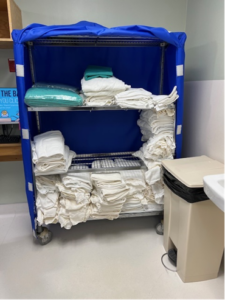The age-old conundrum of fitting a round peg into a square hole is a lot like storing medical supplies. Today’s patient care activities are carried out in facilities designed and built 50+ years ago when there wasn’t a need for as much storage space. This has created situations where clean supply storage encroaches on areas where there are potential contamination risks. This is often found in confined spaces where the need to separate clean from dirty items is a real challenge.
Our consultant teams have observed clean supplies located adjacent to hand hygiene sinks where there is a risk of contamination from water spray and splashes. We have occasionally found storage of supplies under sinks that is not aligned with organizational policy. Additionally, trash receptacles and soiled linen storage are sometimes observed in close proximity to clean supplies, which may result in cross-contamination. Furthermore, staff may not be using shielding, such as linen covers or trash bin lids, to inhibit contamination risks.
Additionally, we are observing medical equipment and devices that have been used on patients and have not yet been cleaned and disinfected collocated with clean equipment.
 The Centers for Disease Prevention and Control (CDC) advises organizations that clean supplies and equipment should not be stored where they may become wet or contaminated. The safe distance for storing clean items from potential sources of contamination is typically set at least 3 feet of separation, although that may not be enough distance depending on activity associated with the contamination source. For example, if there are procedures involving the use of brushes, spray, and splashing, the need to locate clean supplies further away may be necessary. Organizations are encouraged to review their storage practices to determine if reduction in par levels, use of closed storage containers, and more efficient use of space may reduce contamination risks from waste bins and sinks. They should also review their soiled equipment cleaning and disinfection practices to ensure that staff are not intermingling clean and dirty equipment. Environmental rounding should include observations for clean and dirty items that are not separated.
The Centers for Disease Prevention and Control (CDC) advises organizations that clean supplies and equipment should not be stored where they may become wet or contaminated. The safe distance for storing clean items from potential sources of contamination is typically set at least 3 feet of separation, although that may not be enough distance depending on activity associated with the contamination source. For example, if there are procedures involving the use of brushes, spray, and splashing, the need to locate clean supplies further away may be necessary. Organizations are encouraged to review their storage practices to determine if reduction in par levels, use of closed storage containers, and more efficient use of space may reduce contamination risks from waste bins and sinks. They should also review their soiled equipment cleaning and disinfection practices to ensure that staff are not intermingling clean and dirty equipment. Environmental rounding should include observations for clean and dirty items that are not separated.
Please contact us for questions or more information at 704-573-4535 or info@courtemanche-assocs.com.
Courtemanche & Associates specializes in Healthcare Accreditation and Regulatory Compliance Consulting Services. With over 30 years of being in business and 100+ years of healthcare experience amongst our consulting team, we are ready to assist with your accreditation and regulatory compliance needs.

